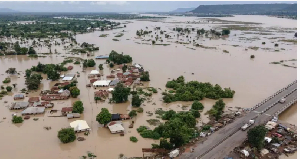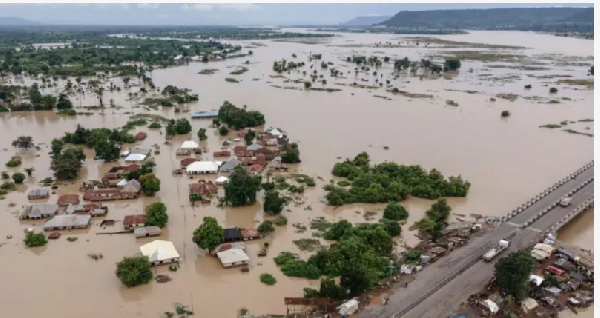 Di federal goment don tok say heavy rains and floods go happun for 30 states
Di federal goment don tok say heavy rains and floods go happun for 30 states
Di federal goment don tok say heavy rains and floods go happun for 30 states and di Federal Capital Territory, Abuja, for 2025.
Na di minister of Water Resources and Sanitation, Joseph Utsev give di informate on Thursday during di public presentation of di 2025 Annual Flood Outlook by di Nigeria Hydrological Services Agency (NIHSA) for Abuja.
Di states include: Lagos, Ogun, Abia, Ondo, Adamawa, Akwa Ibom, Anambra, Bauchi, Bayelsa, Benue, Borno, Cross-River, Delta, Ebonyi, Edo, Gombe, Imo, Jigawa, Kebbi, Kogi, Kwara, Nasarawa, Niger, Osun, Oyo, Rivers, Sokoto, Taraba, Yobe, Zamfara and di Federal Capital Territory.
Utsev say some parts of di south-south geopolitical zone of Nigeria go experience coastal and riverine flooding sake of rise in sea level.
Di states include Bayelsa, Cross River, Delta, and Rivers while Akwa-Ibom and Edo fall under di high-flood risk states.
Di 2025 Annual Flood Outlook (AFO) bin dey segmented into three parts to address di pressing challenges of flood disasters and provide information for mitigation, especially for di most vulnerable communities
According to di minister, flooding remain one of di most devastating natural disasters for Nigeria and climate change dey accelerate im frequency and seriousness.
E reveal say 1,249 communities for 176 local goment areas across 30 states and di FCT fall within high-risk flood zones dis year, while additional 2,187 communities for 293 local goment areas face moderate flood risks.
Key risk areas include Abia, Benue, Lagos, Bayelsa, Rivers, and Jigawa, among odas.
To improve early warning and response systems, dis year AFO introduce a community-based flood forecasting approach.
Instead of just general predictions, dem now tailor forecasts to specific communities to enhance actionable communication and preparation for grassroots level.
For im own remark, di Permanent Secretary of di Ministry of Water Resources and Sanitation, Richard Pheelangwah, urge stakeholders to priorise early response.
“Dis outlook no be just about numbers, na about protecting lives and livelihoods,” e tok.
Di Director General of NIHSA, Umar Mohammed, tok say dis year flood forecast go beyond mapping local goment areas and now identify specific communities at risk.
“Our focus don dey expanded to assess sectoral impacts on health, education, agriculture, and infrastructure, offering more robust tools to policymakers and disaster risk managers,” e tok.
